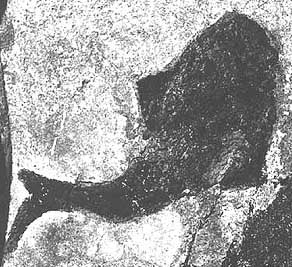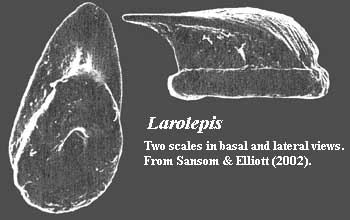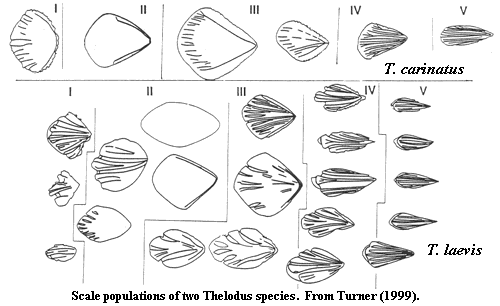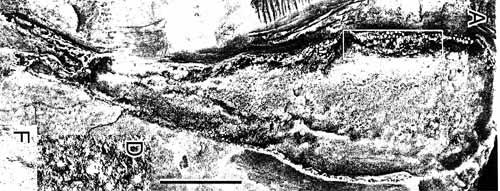 Thelodontida: Boothialepis.
Thelodontida: Boothialepis.| Thelodonti | ||
| The Vertebrates | Thelodontida |
| Vertebrates Home | Vertebrate | Vertebrate |
|
Abbreviated Dendrogram
Vertebrata
├─Conodonta
└─┬─Pteraspidomorphi
└─Thelodonti
├─┬─Furcacaudiformes
│ └─Thelodontida
│ ├─Thelodontidae
│ └─┬─┬─Archipelepididae
│ │ └─Turiniidae
│ └─┬─Apaloepididae
│ └─Lanarkia
└─┬─┬─Katoporida
│ └─Cephalaspidomorphi
│ ├─Galeaspida
│ └─┬─Pituriaspida
│ ├─Osteostraci
│ └─Gnathostomata (conventional placement)
└─┬─Loganiidae
└─Gnathostomata (alternate placement)
├─Placodermi
└─┬─Chondrichthyes
└─Teleostomi
|
Contents
Overview |
One of the things we have not done enough of is to provide quick keys to remembering who's who among the vertebrates. Most of us need a few details as reminders to zero in on what we actually know about a taxon. Accordingly we have prepared the following quick reference, keyed to our rather arbitrary cladogram:
ATW030622
 Thelodontida: Boothialepis.
Thelodontida: Boothialepis.
Range: Middle Ordovician [SE02] to Late Devonian (Frasnian)
Phylogeny: Thelodonti:: (Nikoliviidae + Furcacaudiformes) + *. Thelodontidae + ((Archipelepididae + Turiniidae) + (Apalolepididae + Lanarkia)).
Characters: single pulp cavity [K02]; orthodentine [K02]; base narrower than crown [M86]; dentine tubules or canals open directly into large pulp cavity or depression [BG02]; neck usually distinct [BG02]; relatively high, mushroom-shaped, conical or foliate crown [BG02].
Comments: "Thelodontida" is sometimes mistakenly used instead of Thelodonti.
Image: Lanarkia spinosa from Museon, het populair-wetenschappelijk museum in Den Haag which also has a few other good images of thelodonts.
Links: Lower Devonian (Lochkovian) thelodonts from October Revolution ....
References: Blom & Goujet 2002) [BG02]; Karatajute-Talimaa 2002) [K02]; Marss (1986) [M86]; Sansom & Elliott (2002) [SE02]. ATW030615.
 Thelodontidae: Larolepis, Thelodus.
Thelodontidae: Larolepis, Thelodus.
Range: Middle Ordovician to Late Silurian (Pridoli) of North America, Greenland, Europe, Baltics, Russia, Siberia.
Phylogeny: Thelodontida: ((Archipelepididae + Turiniidae) + (Apalolepididae + Lanarkia)) + *.
Characters: base rounded, smooth, circular or ovate and with a distinct, ring-like (toroidal) rim [SE02]; single, central pulp opening leading to a pulp cavity [SE02]; outline of pulp cavity clear and distinct [K02]; pulp cavity expands in crown? [SE02]; dentine tubules from cavity penetrate base, neck & crown [KM02] [2]; dentine tubules dilated near pulp cavity [KM02]; dentine tubules longest & straightest posteriorly [KM02]; crown striated [SE02]; under surface of crown may also be striated [SE02];
Comments: Sansom & Elliott [SE02] place Larolepis in the "Coelolepididae," which appears to us to be a garbage taxon. They give no explanation for this placement. Donoghue & Smith [DS01] have proposed to recycle this otherwise useless taxon name to mean a clade of  traditional, "flat" Thelodonti (assuming there is such a clade), which seems like a sensible idea. In any case, the very few known scales of Larolepis look almost identical to certain scales of Thelodus matukhini figured by Karatajute-Talimaa & Marss [KM02: 436, fig. 20P1]. Accordingly, we have taken the liberty of placing Larolepis in this foster home until more permanent arrangements can be made.
traditional, "flat" Thelodonti (assuming there is such a clade), which seems like a sensible idea. In any case, the very few known scales of Larolepis look almost identical to certain scales of Thelodus matukhini figured by Karatajute-Talimaa & Marss [KM02: 436, fig. 20P1]. Accordingly, we have taken the liberty of placing Larolepis in this foster home until more permanent arrangements can be made.
See also: Loganiidae for annotated image of thelodont scale histology.
References: Donoghue & Smith (2001) [DS01]; Karatajute-Talimaa 2002) [K02]; Karatajute-Talimaa & Marss (2002) [KM02]; Sansom & Elliott (2002) [SE02]; Turner 1999) [T99]. ATW030606.
Archipelepididae: Archipelepis, possibly Thelodus hoskinsi and Boothialepis [2].
Range: early to middle Silurian of Arctic Canada.
Phylogeny: Thelodontida::: Turiniidae + *.
 Characters: ~6cm [S+01]; head broad and blunt [S+01]; body broad [S+01]; no dorsal or anal fins [S+01]; line of robust scales with smooth surfaces down ventral midline which extend into tail [S+01]; dorsal midline and dorsal lobe of tail probably without reinforcing scales [S+01]; tail slender and hypochordal [S+01]; no paired fins [S+01]; scale base massive and very (perhaps uniquely) deep [S+01]; base cuboidal, with sharp edges [S+01]; pulp cavity very large in juvenile scales [S+01]; pulp cavity closure quite variable [S+01]; orthodentine from long, straight, narrow tubules [S+01]; anterior scales often high [S+01]; scale crown 0.15-0.5 mm, much less massive than base [S+01]; scale neck narrow & constricted [S+01]; ornament turbinate or stellate, with central apex strongly elevated in anterior scales [S+01]; ornament with complex ridges, bifurcating several times [S+01];
Characters: ~6cm [S+01]; head broad and blunt [S+01]; body broad [S+01]; no dorsal or anal fins [S+01]; line of robust scales with smooth surfaces down ventral midline which extend into tail [S+01]; dorsal midline and dorsal lobe of tail probably without reinforcing scales [S+01]; tail slender and hypochordal [S+01]; no paired fins [S+01]; scale base massive and very (perhaps uniquely) deep [S+01]; base cuboidal, with sharp edges [S+01]; pulp cavity very large in juvenile scales [S+01]; pulp cavity closure quite variable [S+01]; orthodentine from long, straight, narrow tubules [S+01]; anterior scales often high [S+01]; scale crown 0.15-0.5 mm, much less massive than base [S+01]; scale neck narrow & constricted [S+01]; ornament turbinate or stellate, with central apex strongly elevated in anterior scales [S+01]; ornament with complex ridges, bifurcating several times [S+01];
Comments: [S+01] note that the very deep (presumably aspidin) base of these scales blurs the line between thelodont scales and heterostracan armor. The bases, being rectangular, are closely packed as in heterostracan armor; and the tubule  histology resembles that of some cyathaspids. The style of ornamentation in Archipelepis is almost unique, but bears at least a passing resemblance to the grebeshki ornamentation which is common in the heterostracan lineage. (Certain Gondwanan turiniids have similar ornament, and others have head scales with ornament much closer to the heterostracan model!) This ornament motif is, however, common to all pteraspidomorphs and may be primitive for the thelodont + pteraspidomorph clade. The structure of the tail is not completely clear, but Soehn believes that it does not resemble the heterostracan model. Finally, note the somewhat corvaspid-style arched scale around the orbit.
histology resembles that of some cyathaspids. The style of ornamentation in Archipelepis is almost unique, but bears at least a passing resemblance to the grebeshki ornamentation which is common in the heterostracan lineage. (Certain Gondwanan turiniids have similar ornament, and others have head scales with ornament much closer to the heterostracan model!) This ornament motif is, however, common to all pteraspidomorphs and may be primitive for the thelodont + pteraspidomorph clade. The structure of the tail is not completely clear, but Soehn believes that it does not resemble the heterostracan model. Finally, note the somewhat corvaspid-style arched scale around the orbit.
Soehn's [S+01] attempt to distinguish Boothialepis Marss 1999 [M99] from Archipelepis is not completely convincing. The two share a large base, basic style of ornamentation, large pulp cavity, and a few other characters. However, the scale neck in Bothialepis is indistinct, Boothialepis has prominent posterior protuberances which are missing or very small in Archipelepis, and the scale histology may be different. Soehn et al. admit that they have little information on histology, but what they have is different from the bunched tubules which are plainly present in Boothialepis.
Images: Archipelepis holotype and detail of scales from [S+01]. Interestingly, there's a Thelodus scale species (T. sculptilis) with quite similar ornamentation from the Late Silurian of Europe, Russia & Siberia. [T99].
References: Marss (1999) [M99]; Soehn et al. 2001) [S+01]; Turner 1999) [T99]. ATW030607.
checked ATW050524